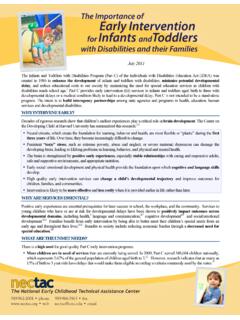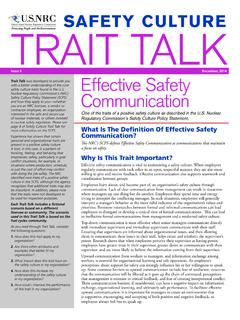Transcription of Theory and Principles of Public Communication Campaigns
1 C H A P T E R 1. Theory and Principles of Public Communication Campaigns Charles K. Atkin and Ronald E. Rice P ublic Communication Campaigns can be defined as purposive attempts to inform or influence behaviors in large audiences within a specified time period using an organized set of Communication activities and featuring an array of mediated messages in multiple channels generally to produce noncommercial benefits to individuals and society (Rice &. Atkin, 2009; Rogers & Storey, 1987). The campaign as process is universal across topics and venues, utilizing systematic frameworks and fundamental strategic Principles developed over the past half century. campaign designers perform a situational analysis and set objectives leading to develop- ment of a coherent set of strategies and implement the campaign by creating informational and persuasive messages that are disseminated via traditional mass media, new technolo- gies, and interpersonal networks. THEORETICAL FOUNDATIONS OF Campaigns .
2 Although no specific Theory has been developed to explain and predict Public commu- nication Campaigns , a number of theoretical perspectives are regularly invoked to guide campaign strategies. The most comprehensive applicable conceptualizations are the social marketing framework and the Communication -Persuasion Matrix. Campaigns across the spectrum of health, prosocial, and environmental domains share some similarities to commercial advertising Campaigns . Thus, it is useful to apply social marketing, which emphasizes an audience-centered consumer orientation and calculated attempts to attractively package the social product and utilize the optimum combination of campaign components to attain pragmatic goals (Andreasen, 1995, 2006; Kotler, Roberto, & Lee, 2002; McKenzie-Mohr, 2011). Social marketing offers a macro perspective, combin- ing numerous components, notably the multifaceted conceptions of product, costs, and benefits, as well as audience segmentation, policy change, and competition (see Bracht &.)
3 Rice in Chapter 20 and Rice & Robinson in Chapter 16). 3. 4 O V E RV IE W AN D HIST O RY. In McGuire's (Chapter 9) classic Communication -Persuasion Matrix, or input output model, the Communication input variables include source, message, channel, and audi- ence; these factors, which are central to most Communication models, will be discussed at length in subsequent sections. The output process posits audience responses to cam- paign stimuli as proceeding through the basic stages of exposure and processing before effects can be achieved at the learning, yielding, and behavior levels. Exposure includes the simple reception of a message and the degree of attention to its content. Processing encompasses mental comprehension, pro- and counterarguing, interpretive perceptions, and cognitive connections and emotional reactions produced by the campaign message. Learning comprises information gain, generation of related cognitions, image forma- tion, and skills acquisition.
4 Yielding includes acquisition and change in attitudes, beliefs, and values. Behavior in the campaign context involves the bottom-line enactment of the actions recommended in messages. Specific central theories that are applicable to various aspects of Public Communication campaign strategies, processes, and implementation include: Agenda setting (McCombs, 2004). The phenomenon of topical salience applies to cam- paign impact on the perceived importance of societal problems and the prominence of policy issues. Diffusion of innovations (Rogers, 2003). This Theory introduces the ideas of relative advan- tage and trialability of recommended behaviors, and the individual adoption decision pro- cess, as well as opinion leadership that shapes diffusion through interpersonal channels and social networks via multistep flows. Elaboration Likelihood Model (ELM) (Petty & Cacioppo, 1986) and Heuristic Systematic Model (HSM) (Eagly & Chaiken, 1993). ELM and HSM highlight the role of audience involvement level as it shapes cognitive responses, thought generation, and central versus peripheral routes to persuasion.
5 Extended Parallel Process Model (Stephenson & Witte, 2001). Effectiveness of fear appeals is enhanced by understanding cognitive processes that control danger versus emotional processes, which control the fear via denial or coping; perceived efficacy influences type of response. Health Belief Model (HBM) (Becker, 1974). Several concepts from HBM pertain specifically to the potency of health threat appeals: susceptibility multiplied by seriousness of consequences and the self-efficacy and response efficacy of performing the recommended behavior. Instrumental learning (Hovland, Janis, & Kelley, 1953). As adapted to mediated communi- cation, this learning mechanism features message-related concepts of source credibility, reinforcement incentives, and repetition of presentation. Integrative Theory of Behavior Change (Cappella, Fishbein, Hornik, Ahern, & Sayeed, 2001). The multifaceted model integrates HBM, Social Cognitive Theory (SCT), and Theory of Reasoned Action (TRA) to specify how external variables, individual differences, and underlying beliefs contribute to differential influence pathways for outcome behaviors, intentions, attitudes, norms, and self-efficacy.
6 CHAPTER 1 Theory and Principles of Public Communication Campaigns 5. Message frames (O'Keefe & Jensen, 2007; Quick & Bates, 2010). This framework focuses on how message appeals are packaged in terms of gain-frame promotion of positive behavior versus loss-frame prevention of negative behavior, especially for audiences likely to dis- play reactance. Self-Efficacy (Bandura, 1997). This key construct highlights the role of the individual's perceived capability of successfully performing behaviors; those who are confident of carrying out recommended actions are more likely to attempt and sustain behavioral enactment efforts. Social Cognitive Theory (Bandura, 1986). SCT emphasizes the processes by which source role models, explicitly demonstrated behaviors, and depiction of vicarious reinforcement enhance the impact of mediated messages. Theory of Reasoned Action (Ajzen & Fishbein, 1980; Ajzen, Albarracin, & Hornik, 1997). The TRA and the ensuing Theory of Planned Behavior (TPB) formulate a combination of personal attitudes, perceived norms of influential others, and motivation to comply as predictors of intended behavior.
7 A key underlying mechanism is based on the expectancy . value equation, which postulates attitudes are predicted by beliefs about the likelihood that given behavior leads to certain consequences, multiplied by one's evaluation of those consequences. Transtheoretical Model (Prochaska & Velicer, 1997). This stage-of-progression model identi- fies subaudiences on the basis of their stage in the process of behavior change with respect to a specific health behavior (precontemplation, contemplation, preparation, action, or maintenance), which shapes the readiness to attempt, adopt, or sustain the recommended behavior. Uses and gratifications (Katz, Blumler, & Gurevitch, 1974; Rubin, 2002). This offers concepts useful in understanding audience motivations for selecting particular media, attending to media messages, and utilizing learned information in enacting behaviors. AUDIENCE SEGMENTATION AND campaign DESIGN. Identifying the Audience campaign design begins with a conceptual assessment of the situation to determine opportunities and barriers and to identify which outcome behaviors would be performed by which people (Atkin & Salmon, 2010; see also Dervin & Foreman-Wernet, Chapter 10).
8 Rather than attempting to reach the broad Public , campaign designers typically identify specific (often at risk ) segments of the overall population. There are two major strategic advantages of subdividing the Public in terms of demographic characteristics, predisposi- tions, personality traits, and social contexts. First, message efficiency can be improved if subsets of the audience are prioritized according to their centrality in attaining the cam- paign's objectives as well as receptivity to being influenced. Second, effectiveness can be increased if message content, form, style, and channels are tailored to the attributes and abilities of subgroups. 6 O V E RV IE W AN D HIST O RY. The design specifies focal segments of the population whose practices are at issue and the primary focal behaviors that the campaign ultimately seeks to influence. The next step is to trace backward from the focal behaviors to identify the proximate and distal determi- nants and then create models of the pathways of influence via attitudes, beliefs, knowledge, social influences, and environmental forces (ideally grounded in one or more theoretical models).
9 The next phase is to examine the model from a Communication perspective, specifying target audiences that can be directly (or, as noted below, indirectly) reached and target behaviors that can be influenced by campaign messages. A sophisticated campaign will seek to affect the most promising pathways guided by a comprehensive plan for com- bining manifold components and an appropriate theoretical framework matched to the desired outcome and the relevant audiences and social systems. Direct Effects on Focal Audience Segments The nature of the substantive problem dictates the broad parameters of the focal audience to be influenced. Most Campaigns aim messages directly at the focal segments, which are subpopulations who might benefit from the campaign because they are at risk for harm or in need of help or improvement. The potential for achieving direct effects depends on the relative prevalence of various types of receptiveness among target audience segments. A fundamental receptivity factor is stage of readiness to perform the practice; Campaigns typically achieve the strongest impact via triggering or reinforcing messages intended for people who are already favorably predisposed (as argued by the Transtheoretical Model).
10 Another key audience segment includes those who have not yet tried the undesirable behavior but whose background characteristics suggest they are at risk in the near future;. many may be receptive to persuasive messages. Those committed to unsuitable prac- tices are not readily influenced by directly targeted Campaigns , so a heavy investment of resources to induce discontinuation tends to yield a marginal payoff. Among focal targets, there are demographic, social, and psychological-based subgroups such as higher versus lower income strata, high versus low sensation seekers, those experiencing psychological or social obstacles in accomplishing certain behaviors, and members of different cultures. Indirect Effects on Interpersonal Influencers and Policy Makers Rather than relying predominantly on direct persuasion, campaigners may attain greater impact by investing effort and resources in campaign components affecting indirect or secondary target audiences who can 1) exert interpersonal influence on focal individuals or 2) help reform environmental conditions that shape behavior.











